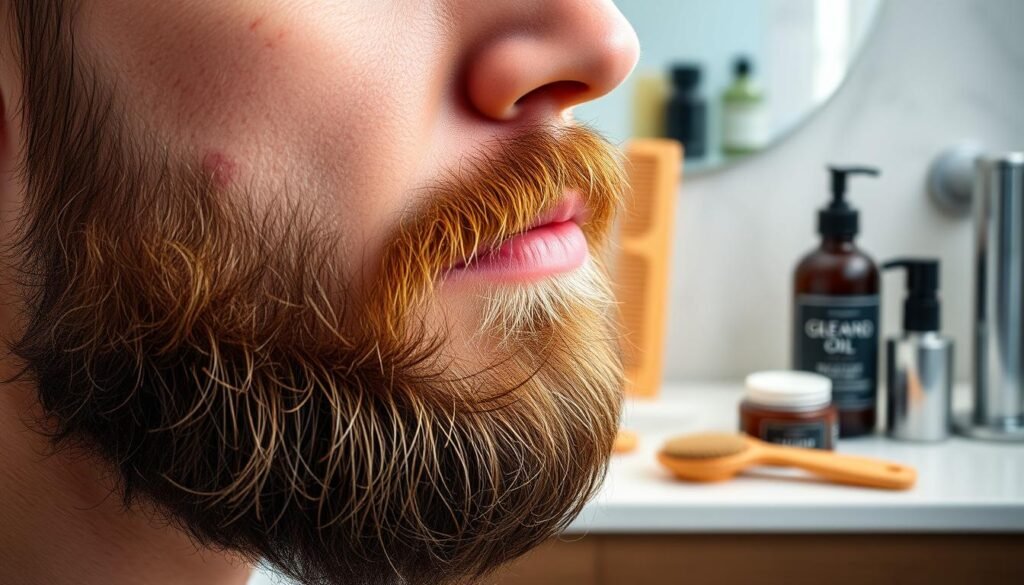
Beard itch is a common problem for many men. It can be caused by dry skin, ingrown hairs, or serious skin issues like folliculitis and seborrheic dermatitis. This article will share expert advice to help you reduce beard itch and keep your beard healthy.
Key Takeaways
- Beard itch can be caused by dry skin, ingrown hairs, and underlying skin conditions
- Proper beard hygiene, including washing and drying, can help prevent and reduce beard itch
- Moisturizing and hydrating the beard with oils and balms is essential for combating itchiness
- Treating underlying skin conditions with medicated products or consulting a dermatologist may be necessary for severe beard itch
- Adopting the right shaving techniques can also help prevent and alleviate beard itch
Understanding the Causes of Beard Itch
When you start growing a beard, the hair follicles can scratch your skin. This makes it itchy. Dry skin is also a big problem, as beard hair takes moisture away from your skin.
Ingrown hairs, where hair curls back into the skin, cause itchiness too. This is more common in people with curlier hair. It’s a big issue for some beard styles.
Growing Out Your Facial Hair
Beard growth starts with itchiness as new hairs come out. This itchiness usually lasts 1-2 weeks. Using beard oils or balms can help during this time.
Dry Skin
Dry skin is a big reason for beard itch. It leads to dandruff and itchiness, especially in cold or dry weather. Using a beard moisturizer with Aloe Vera and Wheat Protein helps keep your skin moist.
Ingrown Hairs
Ingrown hairs can cause long-term itchiness and discomfort. Exfoliating regularly and shaving right can help. If it’s bad, see a dermatologist.
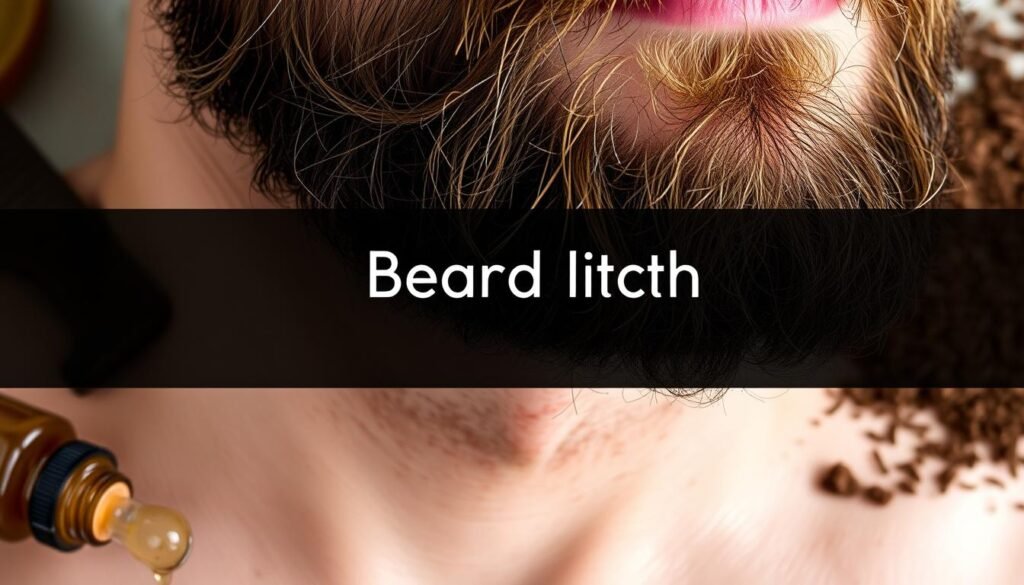
Proper Beard Hygiene and Care
Keeping your beard clean is key to avoiding itch. A few simple steps can greatly improve your beard’s comfort and look.
Washing and Cleansing
Begin by washing your beard every day with a special beard cleanser. Don’t use regular shampoo or soap. They can harm your beard and skin. Massage the cleanser into your beard, focusing on the skin underneath.
Drying Your Beard Correctly
After washing, dry your beard well. Moisture can cause irritation. Use a soft towel to gently pat and blot until dry.
Using a Beard Comb or Brush
Using a beard comb or brush is important. It spreads natural oils, preventing dryness and itch. Brush or comb your beard to remove dead skin and debris.
“Proper beard hygiene is essential for maintaining a healthy, itch-free beard. By following a simple, consistent routine, you can enjoy the benefits of a well-groomed facial hair.”
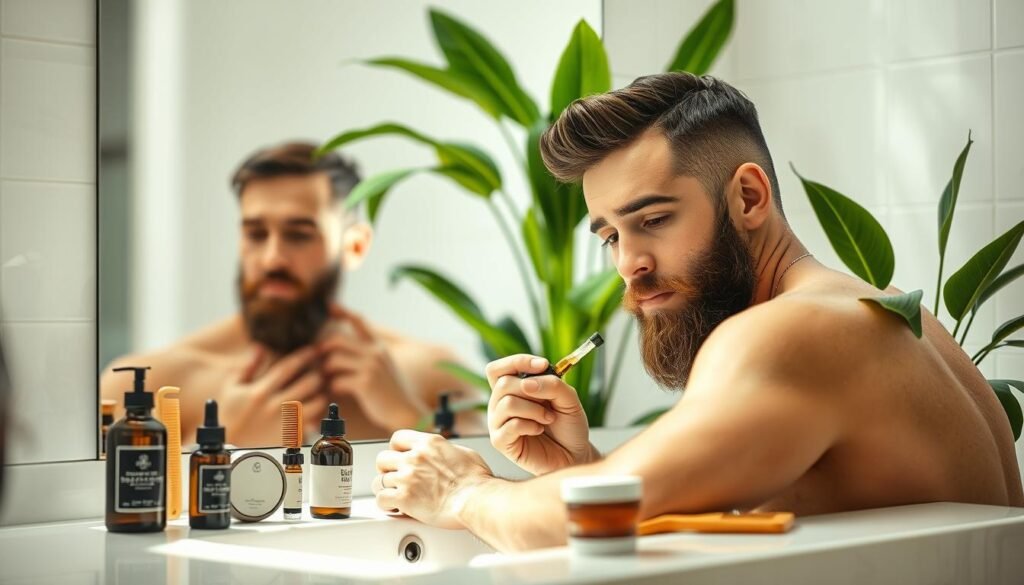
Moisturizing and Hydrating Your Beard
Keeping your beard soft and healthy needs the right care. Use beard moisturizing products like oils, balms, and creams. They can change how your beard looks and feels.
Beard oils are great for beard hydration. They are light and soak in fast. They feed your hair and skin with good fats and vitamins. Just a few drops on your palms, rub them together, and work it into your beard.
For more beard moisturizer and hold, use a beard balm. Balms have butters and waxes. They keep moisture in and help style your beard lightly. Rub a bit of balm into your beard, focusing on the skin underneath.
Having a regular beard grooming routine is key. Brush or comb your beard every day. This spreads the natural oils and beard moisturizer all over.
“Proper beard hydration and moisturization are key to maintaining a soft, healthy appearance.”
Using top-notch beard oils and beard balms helps a lot. Regular grooming fights dryness, itchiness, and other beard problems. Your beard will stay soft, easy to handle, and look great.
How to Reduce Beard Itch
Dealing with an itchy beard can be frustrating. But, there are steps to find relief. Understanding the causes and using the right grooming habits can keep your beard healthy and itch-free.
Using Beard Oils and Balms
Beard oils and beard balms help soothe and reduce itch. They lubricate the hair and skin. Research shows Argan and Jojoba oils are great for this.
Using these products regularly keeps the skin moist. This prevents dryness, a common cause of beard irritation.
Exfoliating the Skin Beneath
Exfoliating the skin beneath the beard is key. Dead skin cells build up and cause irritation. A special brush or scrub can remove this buildup and prevent clogged follicles.
Exfoliate 1-2 times a week to keep the skin healthy and itch-free. This simple habit can greatly improve your beard’s comfort and look.

“Failure to completely dry off a beard post-wash can lead to mineral buildup causing irritation and itching.”
Using beard oils and balms and exfoliating regularly can tackle beard itch. You’ll enjoy a smooth, comfortable beard.
Treating Underlying Skin Conditions
An itchy beard can be a sign of a skin problem like folliculitis, pseudofolliculitis barbae, or seborrheic dermatitis. These need special treatments to fix the itch’s cause.
Folliculitis and Pseudofolliculitis Barbae
Folliculitis is a bacterial infection that makes hair follicles inflamed. This leads to red bumps and itchiness. Pseudofolliculitis barbae, or “ingrown hairs,” happens when curly hairs grow back into the skin. This causes inflammation. Both can make your beard itchy and might need medical help, like antibiotics, to heal and soothe.
Seborrheic Dermatitis
Seborrheic dermatitis is a common skin issue that can hit the beard area. It causes dandruff, flaking, itching, and redness. It’s marked by greasy, yellow or white scales on the skin. To treat it, use antifungal treatments, low-potency steroids, and medicated shampoos. Shampooing regularly and using gentle products can help manage it and reduce flare-ups.
| Condition | Symptoms | Treatment |
|---|---|---|
| Folliculitis | Red bumps, itchiness | Topical or oral antibiotics |
| Pseudofolliculitis Barbae | Inflamed, ingrown hairs | Topical or oral antibiotics |
| Seborrheic Dermatitis | Dandruff, flaking, itching, redness | Antifungal treatments, topical steroids, medicated shampoos |
See a doctor if the itchiness or irritation doesn’t get better or gets worse. These skin conditions need a doctor’s help to get better and avoid more problems.
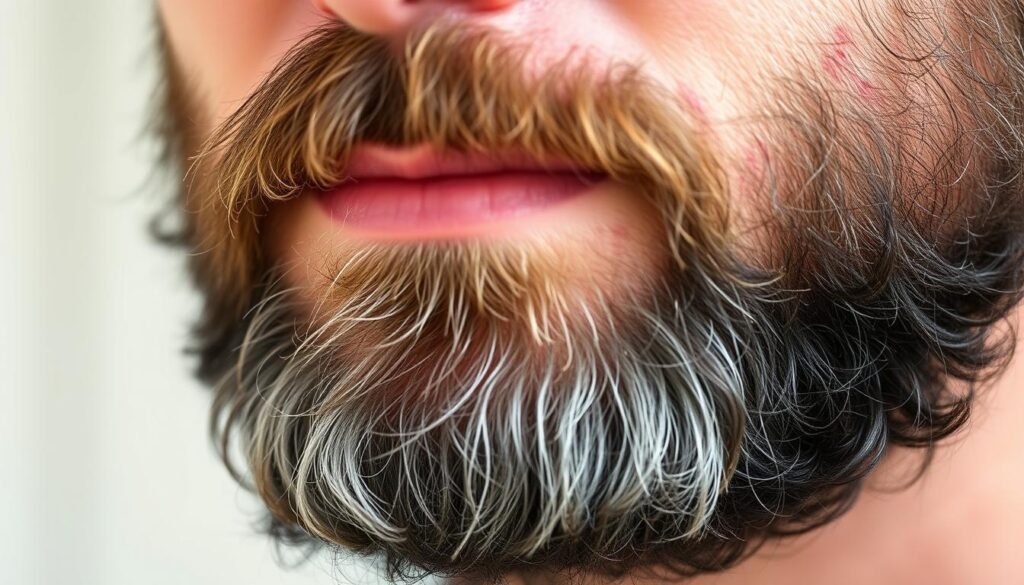
Shaving Tips to Prevent Beard Itch
Proper shaving is key to avoid and lessen beard itch. Shaving tips for beard and stopping itch from shaving include a few important steps:
- Wet the skin and hair before shaving to soften the beard and lessen irritation.
- Use a quality shaving cream or gel to create a protective barrier between the razor and skin.
- Shave in the direction of hair growth to avoid cutting the hair at an angle, which can lead to ingrown hairs.
- Regularly change razor blades to ensure a clean, close shave without the irritation from dull blades.
Also, exfoliating the skin beneath the beard helps remove dead skin cells. This prevents clogged follicles that cause beard itch. Adding these shaving tips to your routine can greatly help in preventing beard itch and keeping your beard healthy and well-groomed.
| Shaving Tip | Benefit |
|---|---|
| Wet the skin and hair | Softens the beard, reducing irritation |
| Use shaving cream/gel | Provides a protective barrier against the razor |
| Shave with hair growth | Prevents ingrown hairs |
| Change razor blades regularly | Avoids irritation from dull blades |
| Exfoliate the skin | Removes dead skin cells and prevents clogged follicles |
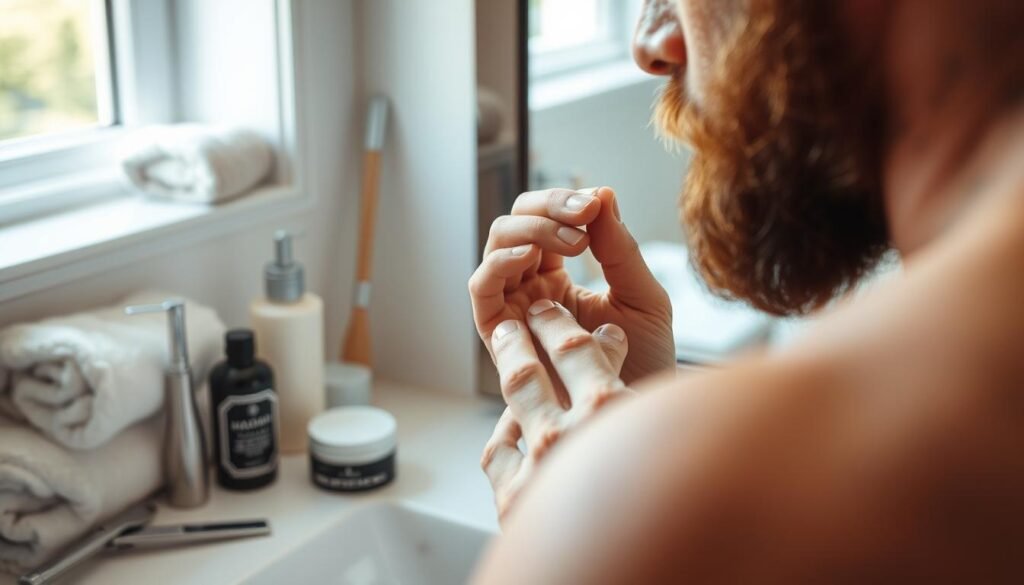
“Incorporating the right shaving techniques can make a significant difference in preventing and reducing beard itch.”
Medications and Treatments for Severe Itch
If home remedies don’t work for beard itch, your dermatologist might suggest stronger options. They could prescribe ointments, creams, or lotions with special ingredients. These medications for beard itch include hydrocortisone, antifungals, or keratolytics. They are strong but targeted treatments for severe beard itch.
Hydrocortisone products can reduce inflammation and soothe irritation. Antifungals fight fungal infections that cause itchiness. Keratolytics help by removing dead skin cells that make your beard itch.
Your doctor might mix different formulas to fit your needs. It’s important to use these treatments as directed. This helps get rid of the itch and keeps it away.
While medications and treatments for severe beard itch can help, don’t forget the cause. Poor hygiene, skin issues, or bad grooming habits can lead to itch. Seeing a dermatologist is key to solving the problem for good.
“Addressing the root cause of beard itch is crucial for long-term relief and maintaining a healthy, itch-free facial hair.”
Surgical and Procedural Options
For those with chronic or severe beard itch, more advanced treatments might be needed. These include surgical and procedural options. They aim to give long-term relief and fix the root problems.
Laser Hair Removal
Laser hair removal can reduce facial hair density, especially for pseudofolliculitis barbae. It targets and destroys hair follicles. This lowers the chance of ingrown hairs and the irritation they cause.
Incisions and Abscess Drainage
In severe cases, draining an abscess might be needed. This minor surgery relieves pressure and pain. It helps the area heal and lowers the risk of more problems.
Beard Transplants
Beard transplants help those with thin or patchy facial hair. They move hair follicles from other parts to the beard. This makes the beard fuller and more even. Some itching after surgery is normal but usually goes away in a week. The full results take about a year to show.
| Surgical Option | Potential Benefits | Potential Drawbacks |
|---|---|---|
| Laser Hair Removal |
|
|
| Incisions and Abscess Drainage |
|
|
| Beard Transplants |
|
|
When looking into surgical options for beard itch or procedures for beard itch, see a qualified doctor. They can help find the best treatment for you. Everyone’s situation is different, so a tailored approach is key.
“The skill of the surgeon and quality of aftercare are crucial for the success of a beard transplant.”
The Main Keyword: How to Reduce Beard Itch
Having a healthy, itch-free beard makes you feel good. It’s about more than looks. It’s about feeling comfortable in your own skin. To reduce beard itch, focus on good hygiene, moisturizing, and treating skin issues.
Follow the expert tips here to stop the itch. Enjoy a softer, easier-to-manage beard.
Prioritize Beard Hygiene
Keep your beard clean and groomed to avoid itch. Wash it with a gentle, sulfate-free. Make sure to rinse well.
Pat dry with a soft towel. Use a good beard comb or brush to detangle and spread oils.
Moisturize for Softness and Comfort
Moisturizing is key to a soft, itch-free beard. Use a nourishing beard oil to soften hair and skin. This prevents dryness and irritation.
Look for oils like jojoba, argan, or coconut for the best results.
Address Underlying Skin Conditions
Beard itch can be a sign of skin issues like folliculitis or seborrheic dermatitis. If itch persists, see a dermatologist. They can find and treat the cause.
| Condition | Symptoms | Causes |
|---|---|---|
| Folliculitis | Red, pus-filled bumps | Bacterial infection, ingrown hairs |
| Seborrheic Dermatitis | Flaky, itchy skin | Excess sebum production, fungal infection |
By tackling the causes of itch and grooming well, you can have a healthy, itch-free beard. This will make you feel confident and comfortable.
“Proper beard care is essential for achieving a soft, itch-free beard. Patience and consistency are key when building a tailored grooming routine.”
Conclusion
Beard itch can be a big problem for men with facial hair. But, the good news is that you can manage it. By knowing why it happens and keeping your beard clean, you can make it itch-free.
Using beard oil regularly can really help. It keeps your beard healthy and looking good. If the itch is really bad, there are medicines and treatments that can help too.
Staying consistent with your grooming is key to beating beard itch. With the right care, you can have a full, healthy beard without itchiness. So, take care of your beard and feel confident with your facial hair.
